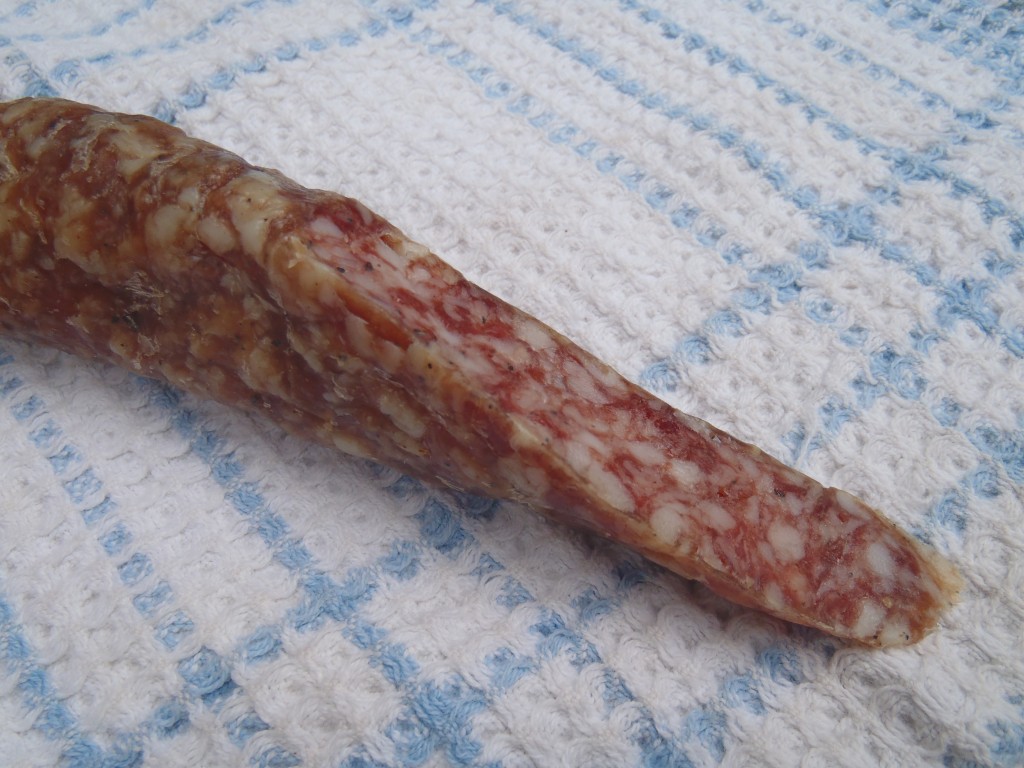 I just finished my first batch of dry-cured sausage. It is essentially fresh ground pork, stuffed into casings with nitrate and seasonings, then left to dry. The temperature and humidity have to be just right for the sausage to dry properly. I experimented with climate-control when making pancetta this past spring. In that case the meat had already been cured in my fridge, and the drying was just to change the texture. The pancetta was also cooked before eating. This is a whole other ball game, as these sausages aren’t cured in the fridge beforehand, and aren’t cooked before eating.
I just finished my first batch of dry-cured sausage. It is essentially fresh ground pork, stuffed into casings with nitrate and seasonings, then left to dry. The temperature and humidity have to be just right for the sausage to dry properly. I experimented with climate-control when making pancetta this past spring. In that case the meat had already been cured in my fridge, and the drying was just to change the texture. The pancetta was also cooked before eating. This is a whole other ball game, as these sausages aren’t cured in the fridge beforehand, and aren’t cooked before eating.
Dry-curing is an interesting process. With most charcuterie preparations, there are easily-described visual indicators to guide you along. For instance, when grinding meat, you look for a clean extrusion from the die, with each stream of ground meat remaining distinct from its neighbours. If the streams smear together in globules, either your meat and fat are too warm, or perhaps the grinder blade has collected connective tissue and needs to be cleaned. When dry-curing, you have to rely on subtle changes in the feel of the meat. The textures and densities are hard to describe to the beginner.
Given the mysterious and temperamental nature of the process, I’m sure most charcutiers take thorough notes on temperature, humidity, and the feel of the meat at each stage of curing, though they don’t seem to share these notes very often.
On the contrary, charcutiers are legendary for their secrecy. Some examples:
- “Good charcuterie recipes are as closely guarded as family secrets. As a young cook in Moissac, France, I had to spy and even participate in the killing of my neighbor’s pig just to get his pâté recipe.” Eric Ripert, in a review of Ruhlman’s Charcuterie
- “He seemed less than happy about aiding us, probably because he was having second thoughts about letting go of his family’s priceless boudin noir. After both Fred and I again pledged that we would not publish a recipe giving exact quantities, he relented, remaining slippery on only one or two matters.” Jeffrey Steingarten, It Takes a Village to Kill a Pig
- This ridiculous article, succinctly titled, “Chefs become experts at charcuterie thanks to secret website”
Here are some basic notes on my first attempt, notes that I hope to elaborate as I do more curing.
Preventing Case Hardening
According to my humidity meter, the curing room was at 65% humidity, which is very good (though 70% would be ideal). I slowly developed a mistrust of this hygrometer, as over the first two days of curing the casings dried out completely. During this period, the casings should be a little tacky if you run your thumb over them. My casings were dry and smooth, offering no moisture-indicating friction when rubbed. To prevent the outermost parts of the sausage from hardening and trapping moisture within, I started misting the sausages with water a couple times a day. I did this from about day three until day seven.
Judging Doneness
I’m kicking myself for not weighing the links before I hung them up, because a good indicator of doneness is when the sausages have lost 30% of their weight. I was left squeezing the sausages every day, trying to decide when they were done. After three weeks they still had a slight give in the centre. A few more days and they were stiff throughout.
Preserving Shape?
When the sausages were first hung they were shaped like any other fresh sausage, cylindrical and tightly packed, the casings pulled taut. As the sausages lost moisture, they did not shrink uniformly into slender cylinders, but shrank in only one dimension, forming an elliptical cross-section instead of a round one (see photo below). Made for a very “rustic” product. The shrinkage patterns don’t seem to be related to how I hung the sausages. I wonder if there is a way to control this.
